Hypothesis: Businesses want to be customer-centric but can’t see the trees (data) through the forest (pictures)…and we’re not helping
Isn’t it time we re-evaluated our old mental models describing why customers purchase a product or service? They have done so little to describe why our products are valued more than others; let alone provide the necessary inputs for innovative new products or services — especially those that create new platforms and markets.
Yet, even today, the emerging thought leadership tends to double down on approaches that don’t provide long-term results — to the point where we are using single statements like progress, or “new me” to describe what is ultimately a far more complex reality. You simply can’t replace worlds like “innovate” with another word that we all define differently.
The lens of a current solution does not provide a stable platform for analysis
The new Zero Moment of Truth is that we can no longer afford the luxury of well-packaged workshops that are nothing more than preschool exercises. Nor should we continue to embrace lazy thought-leadership that simply ignores long-standing research and theory which have been industrialized into market-ready models…that just happen to be inconvenient to current business models.

Companies still embrace pretty, inside-out models
It’s great fun, because we all get a couple of days off from our routine work, get a free lunch, and sit around and come up with ideas all day long. We’re packaging our escape from reality into a nice shiny box that demonstrates the progress we made with a picture.
When we’re done, we have a poster with a fake persona — with fake attributes — and a fake journey which only represents what the company can (or wants to) see or imagine…based upon their current offering(s).
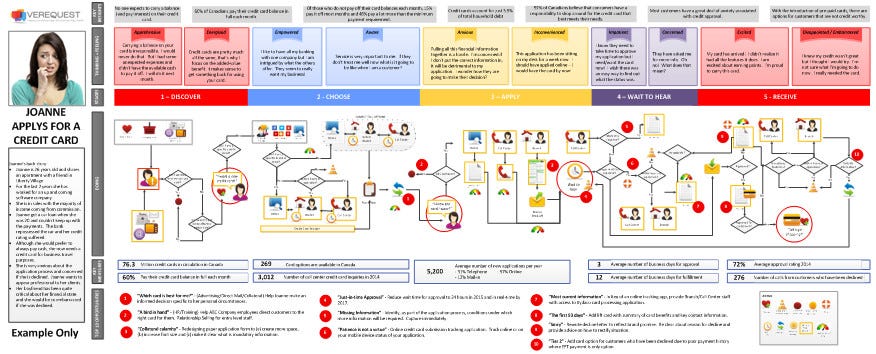
Let’s face it…we make this stuff up! It doesn’t matter how well-planned and executed the workshop is, at the end of the day, we must ask ourselves if this represents a true segment of our customer based or the journey they are really taking. Yet businesses continue to believe they are finding actionable insights simply because they went through a facilitated exercise that generated lots of ideas.
Why?
The qualitative data we’re able to capture is often obtained from surveys (e.g. “what is your pain?”); resulting in unstructured inputs that must be synthesized, and force-aligned to steps that are perceived from the company’s perspective — at best. We have no common understanding of what our customers are trying to accomplish, and no common language to describe it: unless you believe we all define “delighters” the same way. I guarantee you, we don’t — one size never fits all.
Let’s face it, customers are not trying to engage with your brand, or your products (unless you mean engaging the motor on a circular saw). Using a brand-focused journey slams the door shut on any hope of innovating beyond the minor sustaining innovations which must be continually addressed and are easy to copy. We can’t simply come up with ideas to remove friction from the ZMOT and urge customers to share their UMOT to create the next person’s ZMOT. Confused? Yea, so am I!
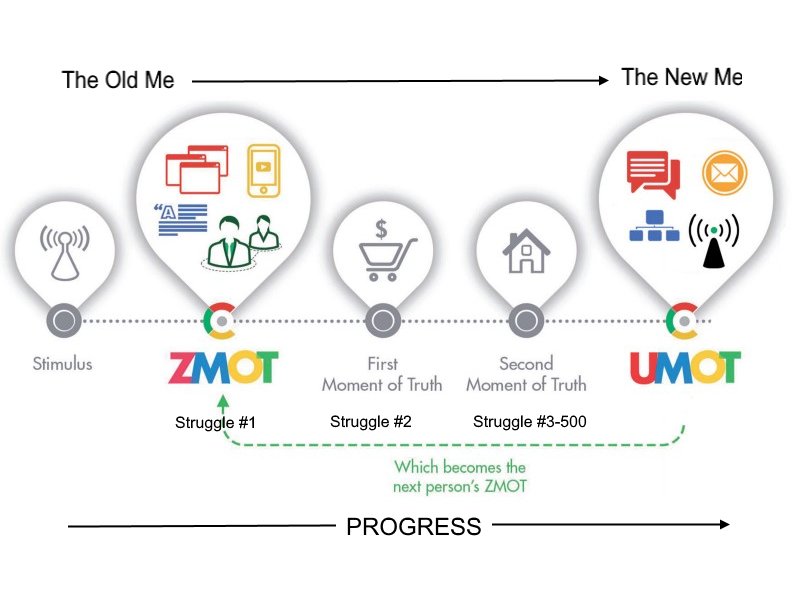
Customer Experience requires more granularity, yet a broader scope
In order to truly understand a customer’s journey we should all agree that what they are trying to accomplish when they interact with a brand has a broader scope than brands generally see, or understand. This broader scope is the customer’s job-to-be-done built from the core job (getting something accomplished) to the related consumption jobs necessary to optimize the experience with a particular solution or approach.
In partial example I’m about to share, the customer is not trying to purchase paint. They are trying to paint a room.
You will hear a few shrill and inexperienced voices suggest that you can innovate by understanding the shopping experience, or the purchase journey. Yet, they can provide no real customer cases to support it.
In the example below, the purchase journey(s) would be located somewhere in the Locate category within this Universal Job map. And as you can see, there are decisions that need to be made— e.g. do we by paint, do we hire a painter, etc.? Thus, a real job map would be a bit more elaborated.
If you want to see how to analyze a purchase journey — a legitimate part of the customer experience — check out this comprehensive diagnostic developed by Strategyn and Harte Hanks (and don’t forget to follow the links inside for more goodies).
Can Bricks and Mortar Compete with On-line Retailing
A shopping journey is offering-centric, and if you want to locate growth opportunities in your business, the best way to view the market is not through the lens of your product, but the job the customer is trying to get done. This is possibly a reason Home Depot not only sells paint, but also provides contracting services who will do the painting for you. You can also find building materials that are better suited to receiving paint than others. They didn’t figure this out by watching you purchase a paint brush.
As I elaborated in this map, you’ll notice that there are multiple approaches baked into the comments. Those are possible solutions depending on your needs and are reflected in the far more rigorous collection of outcome statements that get applied to each step. In short, the job is the same but different groups of job executors will have different needs and we won’t know them until after we’ve done our quantitative analysis (you’re looking at a qualitative analysis here).
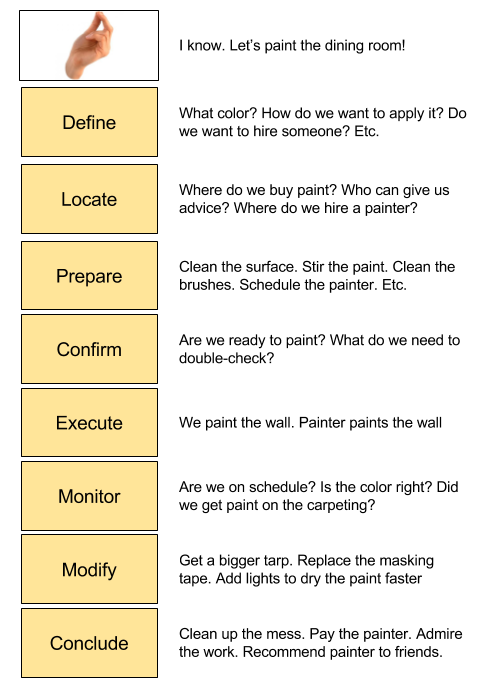
Most journey maps you’ll see exist within a single step of a Job Map, and there is nothing wrong with that, really. In fact, each step in a job map could have it’s own job map. The problem is that there is no guarantee that we haven’t missed something; because the journey map is not a complete representation of reality.
Jobs are hierarchical, and thus, customer experience must recognize the hierarchy. At the top of the hierarchy will be the core job-to-be-done. Investigating the experience lies in the depths below — and this is called the consumption chain. You can’t look at a single consumption job of an offering alone, or you will miss opportunities and threats in the market. You will have also defined the market incorrectly as a product or product category.
Customer experience is far more complex than that, so it’s critical that we paint a complete qualitative picture, perform targeting analysis quantitatively over time, so we can pinpoint precisely where our resources should be applied at any given time and quickly align or integrate capabilities correctly the first time we try.
You can find a great primer for mapping customer jobs below. This is not a lab, as it has already been tried and tested for years and years with great success (and lots of case studies)
The Customer-Centered Innovation Map.pdf
The consumption experience
The consumption chain does relate to a specific approach, and as a result it will potentially hire a number of products and/or services to get various steps in the job done. In the example above, we know we are going to paint the wall one way or another. In the core job, which might address the aesthetics of the home, we have already made the decision not to go with wallpaper, or faux brick, or wood paneling.
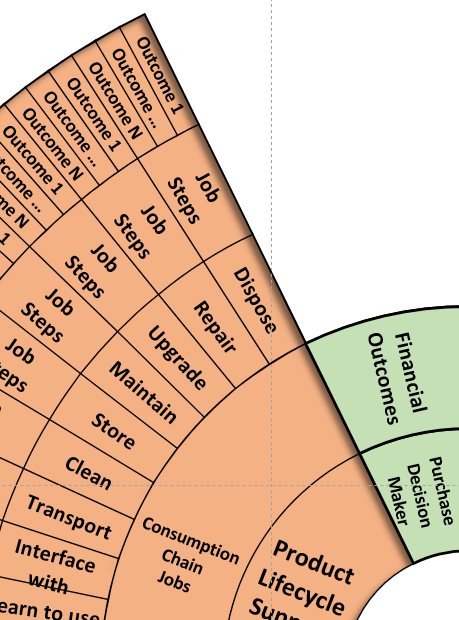
So now that we have made our decision, the experience begins.
Since I suggested that journey maps don’t have real data, I guess I have to explain myself. This is where we dive into more granularity. In this more granular and evidence-based process we’ll capture every single customer need that could possibly be evaluated while executing the job of painting a dining room. Notice I didn’t say unmet needs.
As we all know, we can’t lump customers into persona-based segments that are based on age, geography, and/or earning power.
Oh, you didn’t know that?
We hear people say this all the time, but then they go right back to creating personas and journey maps using these these useless assumptions. They’re useless because they could be right, or they could be wrong…we just don’t know with any confidence. If you do, you’re special. Unfortunately…
“A bad system will beat a good person every time” ~Deming
By capturing every customer need we can then find those which are underserved. Focusing on these, we can then find groups within these that are highly differentiated. When defining a market as a Job-to-be-done plus the Job Executor, these highly differentiated groups (based on unmet needs) become market segments. These segments become the basis for our profiles, or let’s just call them personas to really confuse everyone! Notice that personas are a result of a systematic process, not an ideation session. Therefore, they are valid.
Define — this is the first step in a Universal Job Map (there are other versions specifically designed for service innovation). In most scenarios, you will treat this like a category as there could be multiples steps that you want to highlight. For example, we might want to Determine the paint color, or Determine when to paint the room and capture customer needs against each step.
We’re going to keep it simple. Here are a handful of possible customer need statements you might gather (Note: I did not go through an exercise to capture these, they are all made up — just like in a journey mapping workshop!)
- increase the likelihood that the color selected complements its surroundings
- minimize the time it takes to select the right color
- increase the likelihood that painting is completed on time
- increase the likelihood that the end result is of high quality
- etc. etc.
For more information on how to capture and construct a customer need statement (so we are all doing it the same way) check this out:
Ulwick_Giving_customers_a_fair_hearing_MIT_Sloan_2008.pdf
As we go through each step of the job map, we will try to capture 5–10 of these customer needs statements.
- These are an integral part of the qualitative assessment of the job-to-be-done.
- When taken in their totality with the job map, they become a re-usable value model for a job-centric market and the basis for all future quantitative analysis.
We could end up with 100 or more of them; which helps us understand what perfect execution of the job looks like from the customer’s perspective. Within this catalog of needs, however, we are very likely — actually, certain — to find that different people will evaluate each need differently. Think about that for a minute as you look back upon journey maps you’ve created. We are creating data-driven personas around actual needs and not more common factors like demographics and other perceptions.
Differentiated segments are critical
For example, there are some people who love the process of looking for colors and prefer to spend a lot of time thinking about them. On the other hand, I just want to get it done quickly. And frankly, I don’t think the color is very important. So, when we score this specific need along the dimensions of importance and satisfaction my wife and I are not the same. We share the same income, same home, same zip code…yet we have different unmet needs.
As a marketer, you certainly need to know who the decision-maker is; but understanding the roles my wife and I play is highly critical as well — maybe more so. My wife may be making the decisions; but when I go out on the journey I still want to get the purchase done quickly and you had better help me make that happen. I want to get the walls painted quickly as well; my wife couldn’t care less.
This is important to understand from both a marketing, and a product/service development perspective. I need quick answers, she wants a rich and immersive experience. Now, we can’t tell this all from a single need; but when we look across the catalog of needs for this job after scoring against a population of job executors, a little bit of basic statistics magic will surface groups within the population that are different.
These are your segments. They are BETTER than moments of truth. These are the absolute unmet needs for each of your segments (again, these are made up metrics, and I didn’t score them either! Made up, just like traditional personas — but when applied in real-life, they are not made up). I’m clearly in segment 2.
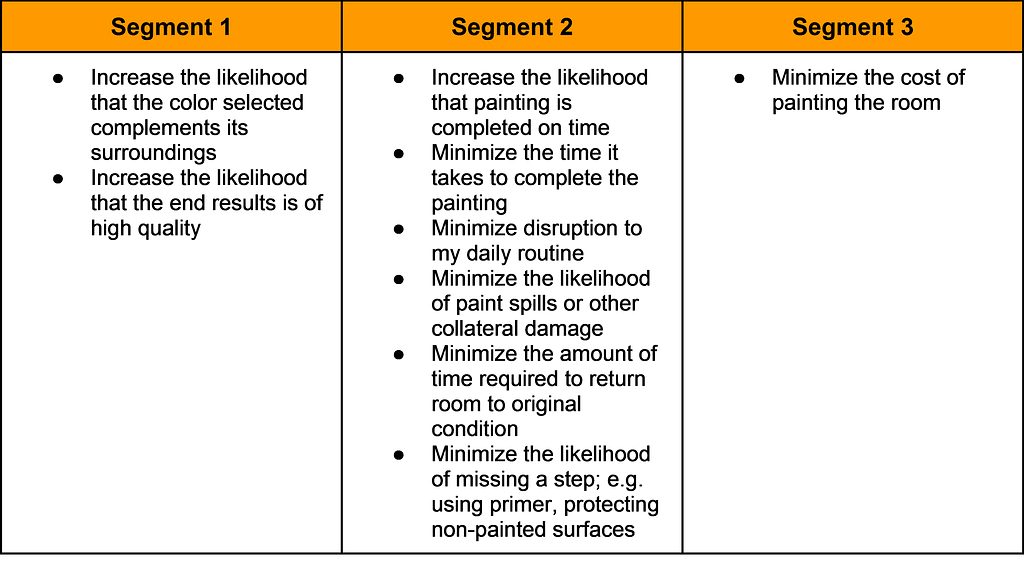
During the quantitative phase of the exercise, we also make sure to capture other critical attributes about a respondent. This allows us to trace needs to a more traditional understanding of customer segments/personas. These are the moments of truth you should be looking for.

Since we are investigating this job at a pretty high-level (e.g. the job is not “Paint room with no streaks”) we will find differentiation as different people struggle to get the job done in different ways. It’s the same job, but now we can segment the market using real data that means something. We don’t all have the same unmet needs, so don’t approach your analysis assuming that we do.
A contrarian, new, and less mature jobs-to-be-done approach I’ve seen by some product designers is to create an abstract job statement with a single need built-in. This clearly does not get the job done in real, complex Enterprises
In the real world
I’ve found myself in journey mapping situations in the past. It’s really unavoidable due to all of the hype, and time professionals spend getting certifications, etc. But, these exercises are fertile ground if you also want to capture jobs, map jobs, and identify outcome metrics. In fact, I have created job maps disguised as journey maps. I know, I’m evil 🙂
What I’m suggesting with job mapping is clearly something you can’t simply force into these common situations. I often get grief for my perspectives on these things but I have found a stable platform to get my job done; a platform that doesn’t shift with the winds like Social CRM, Digital Transformation, the Sharing Economy and other such terms. They emerge, get the life sucked out of them and then they die. Jobs last, even if solutions get some steps done so well, that we don’t even think about them any longer (some might say they are no longer jobs…I disagree).
I’ll say it again, a customer job is stable over time. Your solution is not. Developing a stable meta-data-driven platform for analyzing the world around you means you don’t continually have to re-invent your approach to analyzing markets and customer experience. You may need to change, or add to your business model on occasion (which should be inevitable). But, you’ll do so with a greater degree of confidence, building upon prior work instead of starting from scratch each time. This should be your moment of truth.
In closing, I purposely put links to content that goes much deeper for the simple reason that I don’t have the time to rehash prior writings by myself or others that have taught me. This is the beauty of the web. Take advantage of it!
Understanding Moments of Truth BETTER with Jobs Theory was originally published in Effective CRM through JTBD on Medium, where people are continuing the conversation by highlighting and responding to this story.



